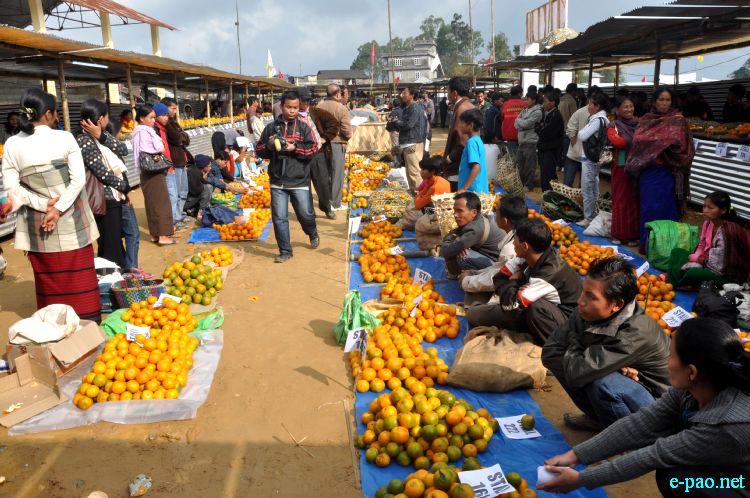: The Centre’s newly framed agriculture export policy — which
aims at reinvigorating the entire value chain from export-oriented farm
production and processing to transportation, infrastructure and market
access — would lay prime focus on exporting fresh fruits and vegetables
from the northeast to foreign markets.
Export of vegetables from Assam has gained momentum since November
last year, when the government of India launched direct custom clearance
facility for agri-export from the Guwahati airport to foreign destinations.
In the northeast, the Agricultural and Processed Food Products Export
Development Authority (APEDA), the coordinating agency of the Union
ministry of commerce and industry, has created five packhouses for fresh
fruits and vegetables with state government agencies in Assam, Sikkim and Mizoram. A walk-in cold storage at Aizawl airport
has been established under the infrastructure scheme for maintenance of quality to enhance export from the state.
The agri export policy, announced in January this year, aims at providing an institutional mechanism for pursuing market
access, tackling barriers and dealing with sanitary and phytosanitary issues and enabling farmers to get benefits of export
opportunities in overseas markets.
For creating awareness among the farmers and other stakeholders, APEDA is organizing a buyers-sellers meet in March, roping
in importers from the Asean and the Middle East. APEDA has been exploring various aspects of agri export and the procedural
requirements for export of fresh fruits and vegetables from the northeastern region.
“The agri export policy will pave the way for organizing the supply chain of agri exports from Assam, benefiting the farmers
from grassroots,” said APEDA chairman Paban Kumar Borthakur.
The agriculture export policy has been framed with a focus on agriculture export-oriented production, export promotion, better
farmer realization and synchronization within policies and programmes of the Centre. “It is required to have a farmer-centric
approach for improved income through value addition at the source itself, which will help to minimize losses across the value
chain,” said an official of the Union ministry of commerce and industry.
“The objectives of the agriculture export policy are to diversify our export basket, destinations and boost high value and value
added agricultural exports including focus on perishables, besides promoting novel, indigenous, organic, ethnic, traditional and
non-traditional agri products exports,” he added.
_____________________
| Hypermarket chain with a presence in the Gulf, and are exploring options to procure fruits from the North-East. Procuring agri-commodities from India for their stores in West Asia is nothing new to the group. But coming to Guwahati for strawberries or bananas is new. The credit goes to the Assam government’s year-long promotion of agri-horticultural exports.Struggling farm sectorThe issue is tricky. When it comes to farm production, the region is largely dependent on supplies from the rest of India. Except in Lower Assam, agriculture is a single crop affair. The yield is low as farm techniques are conventional. There are only 29 soil-testing laboratories in the entire region.Yet, the North-East produces some of the finest varieties of seasonal farm products. But either the production is small or scattered in pockets.All the four processing units of the North-East Regional Agricultural Marketing Corporation are idling. Bangladesh-based PRAN, which had set up a pineapple processing unit in Tripura, imports concentrate as the local procurement is low.Four years after it was set up in Nalbari, Assam, the North-East Mega Food Park is yet to push local value-addition. Half of the 27-acre facility is unused, while the other half has units making pastries or noodles with materials sourced from outside the region.“Failure of the Food Park project was inevitable as it was not customised for the region. The region’s agri-production profile demands innovative solutions to procure in low quantities from a wide area,” said Ronn Pakrashi, former CEO of the Food Park.The World Bank recently initiated a project to promote agri-processing clusters in Assam. But these will take years to deliver.To address the issue of low returns for its produce, the Commerce and Industries Department of Assam turned to exports.“Farmers here barely use chemical fertilisers. We are trying to capitalise on it,” said a State Government official.It tied up with some 450 farmers for supplying products graded and sorted to customer’s choice.According to State government sources, the initiative worked. A dozen trucks carrying vegetables left for Nepal every month this winter. Some buyers from Maharashtra and Karnataka procured potatoes. Bhutan imported a fair quantity of mushrooms.However, the crowning moment came in November 2018 when SpiceJet ferried a consignment of farm products from Guwahati to Dubai.Tea industry benefitsBenefits of these initiatives helped greatly Assam’s tea industry, which was exporting via Kolkata. According to State government sources, beginning April, SpiceJet will ferry tea to Europe from GuwahatiFarm products may be shipped from July.While tea may be doable as planters are well-prepared, there are some questions about the State’s plan to promote farm product exports.Many problemsM Krishna Saikia, partner of Greencover Overseas, a Guwahati based exporter, flags many issues.Greencover exported 40 tonnes of vegetables by sea over the last couple of months. Due to non-availability of authorised packing services in Guwahati and low availability of refrigerated containers in Kolkata, he is routing exports through Mumbai, taking a hit in profitability.Saikia also flags issues of limited knowledge of farmers on pesticide residue, plant quarantine and quality.Five consignments have so far been sent from Guwahati airport, giving a tough time to airport quarantine officials. At least one was rejected due to pesticide-residue issues.“Infrastructure inadequacies make exports from Guwahati costly, and it will take two-three years of effort for things to improve,” he said.ReplyForward |



